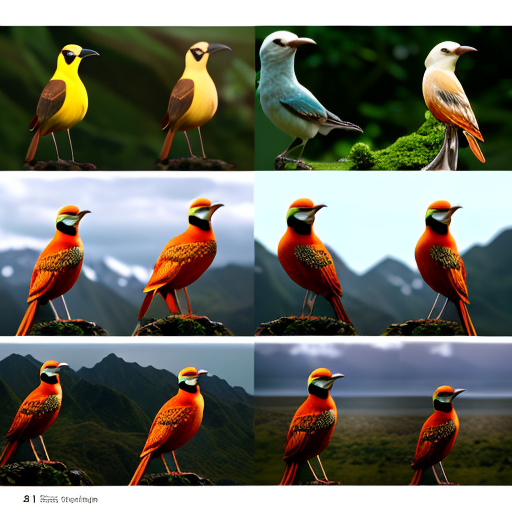Hundreds of Andean bird species at risk due to deforestation: New research shows how to protect them
Hundreds of Andean bird species at risk due to deforestation: New ... University of Florida


Birds in the Tropical Andes Threatened by Agricultural Development, Study Finds
Native bird species in the tropical Andes, many of which are found nowhere else, are facing increasing threats from agricultural development in the region. A new study conducted by researchers from the University of Bern and the Florida Museum of Natural History highlights the impact of habitat loss on specific bird species and proposes potential conservation measures to mitigate human-driven disturbances.
Study Methodology and Findings
The researchers conducted a meta-analysis of existing papers on birds in the Andes and combined it with five years of fieldwork in Peru. The study revealed that open farmlands contribute to a decline of up to 60% in the number of bird species in an area. This research fills a significant data gap regarding which species are declining and to what extent.
Conservation Needs and Recommendations
Each bird species in the Andes has unique habitat requirements and dietary preferences. The study documents how specific species are affected by habitat loss and provides tailored guidance for conservation efforts. The researchers emphasize the importance of preserving forest fragments, as mature forests act as reservoirs for bird diversity. They also suggest leaving some trees untouched in grazing pastures and maintaining shrubby habitats preferred by certain bird species.
Sustainable Development Goals (SDGs)
- SDG 15: Life on Land – The study highlights the need to protect biodiversity in the Andes and preserve natural habitats for bird species.
- SDG 12: Responsible Consumption and Production – The researchers emphasize the importance of sustainable agricultural practices to minimize habitat loss and its impact on bird populations.
- SDG 13: Climate Action – While the study focuses on agricultural development as the primary driver of deforestation, the researchers acknowledge the role of climate change in transforming forests and its potential impact on bird species.
Conclusion
This study provides valuable insights into the impact of agricultural development on bird species in the tropical Andes. By identifying specific species affected by habitat loss and proposing conservation measures, the research contributes to ongoing efforts to protect biodiversity in the region. The findings also highlight the need for further research on how bird species respond to land use and climate change.
SDGs, Targets, and Indicators
1. SDGs Addressed:
- SDG 15: Life on Land
2. Specific Targets:
- Target 15.1: By 2020, ensure the conservation, restoration, and sustainable use of terrestrial and inland freshwater ecosystems and their services, in particular forests, wetlands, mountains, and drylands, in line with obligations under international agreements.
- Target 15.5: Take urgent and significant action to reduce the degradation of natural habitats, halt the loss of biodiversity, and protect and prevent the extinction of threatened species.
3. Indicators:
- Indicator 15.1.1: Forest area as a proportion of total land area
- Indicator 15.5.1: Red List Index
Analysis:
1. SDGs Addressed:
The article addresses the issue of habitat loss and its impact on bird species in the tropical Andes. This aligns with SDG 15: Life on Land, which aims to protect, restore, and sustainably manage terrestrial ecosystems and halt biodiversity loss.
2. Specific Targets:
The article highlights two specific targets under SDG 15:
- Target 15.1: The article emphasizes the need to ensure the conservation and sustainable use of terrestrial ecosystems, particularly forests, in order to protect bird species from habitat loss caused by agricultural development.
- Target 15.5: The article discusses the importance of taking urgent action to reduce habitat degradation, halt biodiversity loss, and prevent the extinction of threatened bird species in the tropical Andes.
3. Indicators:
The article does not explicitly mention any indicators. However, based on the content, the following indicators can be used to measure progress towards the identified targets:
- Indicator 15.1.1: Forest area as a proportion of total land area can be used to assess the conservation and sustainable use of terrestrial ecosystems, particularly forests, in the tropical Andes.
- Indicator 15.5.1: The Red List Index, which measures changes in the extinction risk of species over time, can be used to monitor the impact of habitat loss and degradation on bird species in the region.
Table: SDGs, Targets, and Indicators
| SDGs | Targets | Indicators |
|---|---|---|
| SDG 15: Life on Land | Target 15.1: By 2020, ensure the conservation, restoration, and sustainable use of terrestrial and inland freshwater ecosystems and their services, in particular forests, wetlands, mountains, and drylands, in line with obligations under international agreements. | Indicator 15.1.1: Forest area as a proportion of total land area |
| SDG 15: Life on Land | Target 15.5: Take urgent and significant action to reduce the degradation of natural habitats, halt the loss of biodiversity, and protect and prevent the extinction of threatened species. | Indicator 15.5.1: Red List Index |
Behold! This splendid article springs forth from the wellspring of knowledge, shaped by a wondrous proprietary AI technology that delved into a vast ocean of data, illuminating the path towards the Sustainable Development Goals. Remember that all rights are reserved by SDG Investors LLC, empowering us to champion progress together.
Source: floridamuseum.ufl.edu

Join us, as fellow seekers of change, on a transformative journey at https://sdgtalks.ai/welcome, where you can become a member and actively contribute to shaping a brighter future.







